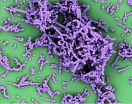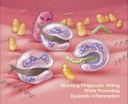(Press-News.org) CHICAGO (June 11, 2014) – New guidelines aim to reduce the prevalence of methicillin-resistant Staphylococcus aureus (MRSA), improve patient safety and prioritize current prevention efforts underway in hospitals. This drug resistant bacterium is a common source of patient morbidity and mortality in U.S. hospitals, causing nearly twice the number of deaths, significantly longer hospital stays and higher hospital costs than other forms of the bacteria.
The strategies were published in the July issue of Infection Control and Hospital Epidemiology and produced in a collaborative effort led by the Society for Healthcare Epidemiology of America, the Infectious Diseases Society of America, the American Hospital Association, the Association for Professionals in Infection Control and Epidemiology, and The Joint Commission.
"Many hospitals have made inroads in preventing healthcare-associated MRSA through essential prevention strategies, but some hospitals need additional intervention," said David Calfee, MD, MS, co-lead author of the guidelines with Cassandra Salgado, MD, MS. "This guidance provides a roadmap for prioritizing and implementing strategies."
Key highlights from the guidelines include:
Conduct an MRSA risk assessment: During the assessment, two important factors to focus on include the opportunity for MRSA transmission (i.e. number of patients who are MRSA carriers and produce risk for transmission) and estimates of facility-specific MRSA burden and rates of transmission and infection (i.e. the ability of facility's current activities to contain MRSA).
Implement an MRSA monitoring program and track rates: Goals of the program should focus on identifying any patient with a current or prior history of MRSA and provide mechanism for tracking hospital-onset cases of the infection. Alerts should be sent out from laboratory to notify HCP of new colonization or cases of MRSA.
Ensure compliance on hand hygiene recommendations: Healthcare personnel should perform hand hygiene in accordance with CDC or World Health Organization recommendations.
Ensure compliance with contact precautions for MRSA-colonized and infected patients: Patients colonized with MRSA should be separated from the general patient population and HCP should wear gloves and gowns when interacting with this patient population to prevent the spread of the bacteria.
Ensure proper cleaning and disinfection of equipment and environment: Because contamination can be widespread among the patient's environment, optimal cleaning and disinfection procedures should be employed.
Educate healthcare personnel, patients and families about MRSA: Personnel, patients and families should be made aware of risk and their role in prevention, transmission and recommended precautions.
Implement an alert system: Notification of laboratory-identified or readmitted patients with MRSA should be instituted to provide timely information and allow prompt initiation of control measures.
"There is no "one-size-fits-all" approach to improving practices. Local contextual factors matter when implementing strategies," said Edward Septimus, MD, an author of the commentary, Approaches for Prevention Healthcare-Associated Infections: Go Long or Go Wide, also published in the July issue.
The new practice recommendations are a part of Compendium of Strategies to Prevent Healthcare-Associated Infections in Acute Care Hospitals: 2014 Updates, a series of articles to be published over several months sharing evidence-based strategies to help healthcare professionals effectively control and prevent the spread of healthcare-associated infections (HAIs). The 2014 release revises the initial 2008 Compendium publication.
INFORMATION:
David Calfee, Cassandra Salgado, Aaron Milstone, Anthony Harris, David Kuhar, Julia Moody, Kathy Aureden, Susan Huang, Lisa Maragakis, Deborah Yokoe. "Strategies to Prevent Methicillin-Resistant Staphylococcus aureus Transmission and Infection in Acute Care Hospitals: 2014 Update." Infection Control and Hospital Epidemiology 35:7 (July 2014)
Published through a partnership between the Society for Healthcare Epidemiology of America and The University of Chicago Press, Infection Control and Hospital Epidemiology provides original, peer-reviewed scientific articles for anyone involved with an infection control or epidemiology program in a hospital or healthcare facility. ICHE is ranked 13 out of 158 journals in its discipline in the latest Web of Knowledge Journal Citation Reports from Thomson Reuters.
About the Society for Healthcare Epidemiology of America
SHEA is a professional society representing more than 2,000 physicians and other healthcare professionals globally with expertise in and passion for healthcare epidemiology and infection prevention. SHEA's mission is to prevent and control healthcare-associated infections and advance the field of healthcare epidemiology. The society promotes science and research, develops expert guidelines and guidance for healthcare workers, provides high-quality education, promotes antimicrobial stewardship, encourages transparency in public reporting related to HAIs, works to ensure a safe healthcare environment, and facilitates the exchange of knowledge. SHEA upholds the value and critical contributions of healthcare epidemiology to improving patient care and healthcare worker safety in all healthcare settings. Visit SHEA online at http://www.shea-online.org, http://www.facebook.com/SHEApreventingHAIs and @SHEA_Epi.
About the Infectious Diseases Society of America
The Infectious Diseases Society of America (IDSA) is an organization of physicians, scientists, and other health care professionals dedicated to promoting health through excellence in infectious diseases research, education, prevention, and patient care. The Society, which has more than 10,000 members, was founded in 1963 and is based in Arlington, VA. For more information, see http://www.idsociety.org.
About the American Hospital Association
The AHA is a not-for-profit association of health care provider organizations and individuals that are committed to the improvement of health in their communities. The AHA is the national advocate for its members, which include nearly 5,000 hospitals, health care systems, networks and other providers of care. Founded in 1898, the AHA provides education for health care leaders and is a source of information on health care issues and trends. For more information visit the website at http://www.aha.org.
About the Association for Professionals in Infection Control and Epidemiology
APIC's mission is to create a safer world through prevention of infection. The association's more than 15,000 members direct infection prevention programs that save lives and improve the bottom line for hospitals and other healthcare facilities. APIC advances its mission through patient safety, implementation science, competencies and certification, advocacy, and data standardization. Visit APIC online at http://www.apic.org. Follow APIC on Twitter: http://twitter.com/apic and Facebook: http://www.facebook.com/APICInfectionPreventionandYou. For information on what patients and families can do, visit APIC's Infection Prevention and You website at http://www.apic.org/infectionpreventionandyou.
About The Joint Commission
Founded in 1951, The Joint Commission seeks to continuously improve health care for the public, in collaboration with other stakeholders, by evaluating health care organizations and inspiring them to excel in providing safe and effective care of the highest quality and value. The Joint Commission evaluates and accredits more than 20,000 health care organizations and programs in the United States, including more than 10,300 hospitals and home care organizations, and more than 6,500 other health care organizations that provide nursing and rehabilitation center care, behavioral health care, laboratory and ambulatory care services. The Joint Commission currently certifies more than 2,000 disease-specific care programs, focused on the care of patients with chronic illnesses such as stroke, joint replacement, stroke rehabilitation, heart failure and many others. The Joint Commission also provides health care staffing services certification for more than 750 staffing offices. An independent, not-for-profit organization, The Joint Commission is the nation's oldest and largest standards-setting and accrediting body in health care. Learn more about The Joint Commission at http://www.jointcommission.org.
New strategies to combat MRSA in hospitals
Infection prevention and control guidance prioritizes strategies
2014-06-11
ELSE PRESS RELEASES FROM THIS DATE:
Targeted mass killings can be prevented
2014-06-11
New Rochelle, NY, June 11, 2014–Disagreeing with comments made by Richard Friedman in a recent New York Times op-ed piece, Mary Ellen O'Toole, PhD, Senior FBI Profiler/Criminal Investigative Analyst (ret.), states that there is "a critical and significant difference" between being able to predict and prevent mass shootings. Dr. O'Toole, who is Editor-in-Chief of Violence and Gender, calls on the media to stop using the names of mass murders, which only fuels their desire for fame and is "a very powerful motivator," in a Perspective in the new peer-reviewed journal from ...
Guidelines needed for creating germ cells in vitro, Cornell, JAX scientists state
2014-06-11
Research aimed at developing germ cells—the progenitors of eggs and sperm—in vitro should be held to especially rigorous scientific standards, a distinguished team of reproductive biologists declares in the journal Cell.
In the article, authors John Schimenti, Ph.D., of Cornell University and his Jackson Laboratory colleagues, Mary Ann Handel, Ph.D., and John Eppig, Ph.D., note that because "germ cells are the ultimate stem cells," laboratories are racing to develop these cells in vitro for assisted reproduction.
Yet the researchers claim that no one has yet conclusively ...
Mining data archives yields haul of 'red nuggets'
2014-06-11
The world of astronomy has changed. An astronomer used to have to travel to a remote location and endure long, cold nights, patiently guiding a telescope to collect precious photons of light. Now, a proliferation of online archives allows astronomers to make discoveries from the comfort of their own offices.
By mining such archives, a team of astronomers led by Ivana Damjanov of the Harvard-Smithsonian Center for Astrophysics (CfA) has found a treasure trove of "red nugget" galaxies. These galaxies are compact and densely packed with old, red stars. Their abundance provides ...
Contextuality puts the 'magic' in quantum computing
2014-06-11
A new theoretical advance explains where the power of quantum computation comes from, and will help researchers design and build better computers and algorithms.
The strange properties of quantum mechanics give quantum computers the potential to perform some computations exponentially faster than conventional computers. But where the extra power comes from – and how best to take advantage of it – is in many ways still an open question.
A new paper in the journal Nature by CIFAR Fellow Joseph Emerson of the program in Quantum Information Science, along with colleagues ...
Gigantic explosion buried in dust: ALMA probes environment around gamma ray bursts
2014-06-11
Using the Atacama Large Millimeter/submillimeter Array (ALMA), a team of researchers reports the first-ever detection of molecular gas -- the fuel for star formation -- in two galaxies that were previously rocked by gamma ray bursts (GRBs), the brightest explosions in the Universe. These new observations revealed that the molecular gas was concentrated toward the centers of the galaxies, while the GRBs occurred in unusual environments that were surprisingly bereft of gas yet rich in dust.
The researchers speculate that the dearth of molecular gas around the GRBs was due ...
Breakthrough study sheds new light on best medication for children with seizures
2014-06-11
DETROIT – A recently published clinical study in the Journal of the American Medical Association has answered an urgent question that long puzzled ER pediatricians: Is the drug lorazepam really safer and more effective than diazepam – the U.S. Food and Drug Administration-approved medication as first line therapy most often used by emergency room doctors to control major epileptic seizures in children?
The answer to that question – based on a double-blind, randomized clinical trial that compared outcomes in 273 seizure patients, about half of whom were given lorazepam ...
Why aren't product designers considering activity trackers for older adults?
2014-06-11
Commercially available activity-monitoring apps, Web sites, and wearable devices allow for easy self-management of health and wellness. This technology may be particularly helpful for older adults, who can improve their cognitive function through proper diet and exercise. Despite tracking monitors' growing popularity and potential benefits, product designers rarely consider those over 65 to be a viable user group, and new human factors/ergonomics research indicates that the technology presents several usability challenges for this population.
"Many older adults have ...
A key step toward a safer strep vaccine
2014-06-11
An international team of scientists, led by researchers at the University of California, San Diego School of Medicine, have identified the genes encoding a molecule that famously defines Group A Streptococcus (strep), a pathogenic bacterial species responsible for more than 700 million infections worldwide each year.
The findings, published online in the June 11 issue of Cell Host & Microbe, shed new light on how strep bacteria resists the human immune system and provides a new strategy for developing a safe and broadly effective vaccine against strep throat, necrotizing ...
A NASA view of Tropical Cyclone Nanauk in the Arabian Sea
2014-06-11
Tropical Cyclone 02A has consolidated and strengthened over a 24 hour period between June 10 and 11 and an image from NASA's Aqua satellite showed a more rounded tropical storm, despite wind shear.
As Tropical Cyclone 02A consolidated and strengthened into a tropical storm it was re-named Nanauk. NASA's Aqua satellite passed over Nanauk on June 11 at 08:29 UTC (4:29 a.m. EDT) and the Atmospheric Infrared Sounder (AIRS) captured an infrared and near-infrared image of the storm. The near-infrared image provided an almost visible look at the clouds that revealed a well-rounded ...
Gum disease bacteria selectively disarm immune system, Penn study finds
2014-06-11
The human body is comprised of roughly 10 times more bacterial cells than human cells. In healthy people, these bacteria are typically harmless and often helpful, keeping disease-causing microbes at bay. But, when disturbances knock these bacterial populations out of balance, illnesses can arise. Periodontitis, a severe form of gum disease, is one example.
In a new study, University of Pennsylvania researchers show that bacteria responsible for many cases of periodontitis cause this imbalance, known as dysbiosis, with a sophisticated, two-prong manipulation of the human ...
LAST 30 PRESS RELEASES:
Why nail-biting, procrastination and other self-sabotaging behaviors are rooted in survival instincts
Regional variations in mechanical properties of porcine leptomeninges
Artificial empathy in therapy and healthcare: advancements in interpersonal interaction technologies
Why some brains switch gears more efficiently than others
UVA’s Jundong Li wins ICDM’S 2025 Tao Li Award for data mining, machine learning
UVA’s low-power, high-performance computer power player Mircea Stan earns National Academy of Inventors fellowship
Not playing by the rules: USU researcher explores filamentous algae dynamics in rivers
Do our body clocks influence our risk of dementia?
Anthropologists offer new evidence of bipedalism in long-debated fossil discovery
Safer receipt paper from wood
Dosage-sensitive genes suggest no whole-genome duplications in ancestral angiosperm
First ancient human herpesvirus genomes document their deep history with humans
Why Some Bacteria Survive Antibiotics and How to Stop Them - New study reveals that bacteria can survive antibiotic treatment through two fundamentally different “shutdown modes”
UCLA study links scar healing to dangerous placenta condition
CHANGE-seq-BE finds off-target changes in the genome from base editors
The Journal of Nuclear Medicine Ahead-of-Print Tip Sheet: January 2, 2026
Delayed or absent first dose of measles, mumps, and rubella vaccination
Trends in US preterm birth rates by household income and race and ethnicity
Study identifies potential biomarker linked to progression and brain inflammation in multiple sclerosis
Many mothers in Norway do not show up for postnatal check-ups
Researchers want to find out why quick clay is so unstable
Superradiant spins show teamwork at the quantum scale
Cleveland Clinic Research links tumor bacteria to immunotherapy resistance in head and neck cancer
First Editorial of 2026: Resisting AI slop
Joint ground- and space-based observations reveal Saturn-mass rogue planet
Inheritable genetic variant offers protection against blood cancer risk and progression
Pigs settled Pacific islands alongside early human voyagers
A Coral reef’s daily pulse reshapes microbes in surrounding waters
EAST Tokamak experiments exceed plasma density limit, offering new approach to fusion ignition
Groundbreaking discovery reveals Africa’s oldest cremation pyre and complex ritual practices
[Press-News.org] New strategies to combat MRSA in hospitalsInfection prevention and control guidance prioritizes strategies






